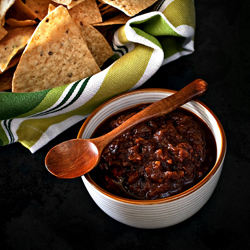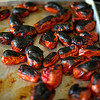Green tomatoes, black salsa
 When life gives you lemons, as the saying goes, make lemonade. When life — or, in this case, a distracted farmer — gives you under-ripe tomatoes, make salsa.
When life gives you lemons, as the saying goes, make lemonade. When life — or, in this case, a distracted farmer — gives you under-ripe tomatoes, make salsa.
I’d ordered 40 pounds of San Marzano tomatoes from my favorite farm, planning to use some for my contribution to this month’s CanJam — hosted by What Julia Ate — and to pressure-can the rest for this winter’s cooking.
But when I got home and opened the crates, my heart sunk. I’d gotten two whole cases of tomatoes that ranged from rock-hard-green to just-barely-red, with the vast majority in the not-really-ripe category.
Already up to my ears in green-tomato jam from last season’s garden, I really didn’t want to go that route again. Happily, I remembered — no doubt from some wise Rick Bayless recipe — that the judicious application of heat helps less-than-perfect tomatoes become something better than they ought to be. Roasting tomatoes under a broiler gives them a soft, smoky sweetness, making them the perfect base for sauces and salsas.
The most appealing canner-ready recipe I found for roasted tomato salsa calls for a mix of dried chipotles and cascabel chiles. Having neither on hand, I opted for a mix of locally grown guajillos and some chilhuacles de oaxaca left over from a mole-making adventure. (Although you shouldn’t generally tinker with canning recipes, this kind of one-to-one substitution is fine, so long as the ingredients have the same acidity and moisture levels as the ones they’re replacing.)
The resulting salsa is a mix of bright acidity and smoky complexity, garlicky and rich with chile flavor. It’s definitely the best tomato salsa I’ve ever canned, and a great change from our usual tomatillo salsa. And although I seriously hope I’m never confronted with another case of under-ripe tomatoes, at least I now know exactly what to do with them.
Fire-Roasted Salsa Negra
– adapted from the Ball Complete Book of Home Preserving
Makes eight 8-oz jars or four pint jars
 24 dried chile peppers, such as chipotle, guajillo, ancho, etc.
24 dried chile peppers, such as chipotle, guajillo, ancho, etc.
2 cups hot water
3 pounds ripe plum tomatoes
2 large mild to medium-hot green chiles, such as Anaheims (or bell peppers, if you prefer)
2 small onions
1 head garlic, broken into cloves but not peeled
2 tsp white sugar
1 tsp salt
1 cup white vinegar
Preheat your broiler. Meanwhile, toast the dried chiles in a large, dry skillet over medium heat, about 30 seconds per side, until they are softened and fragrant. Transfer softened chiles to a heatproof bowl and cover with the hot water, weighing down with a saucer or small plate to keep chiles submerged. Soak the chiles for 15 minutes.
Working in batches, transfer soaked chiles and some of their soaking liquid to a blender; puree until smooth. Taste the puree; if you find it bitter, press the puree through a mesh strainer or sieve with a wooden spoon. Continue pressing and scraping until you’re left with a dry lump of seeds and bits of skin with no flesh attached.
Meanwhile, roast the tomatoes, peppers, onions, and garlic under the preheated broiler, turning to roast all sides. When the tomatoes and peppers are blistered, blackened, and softened, and the onions and garlic skins are blackened in spots, remove them from the broiler; this usually takes anywhere from 10 to 20 minutes, depending on the age of your vegetables and the strength of your broiler. The garlic will likely need to come out before other vegetables are done, so keep tongs handy.
Set tomatoes, onions, and garlic aside to cool. Place the peppers in a paper bag and roll the top closed tightly; set aside. Peel and chop all of the vegetables as they become cool enough to handle.
Prepare canner, lids, and jars according to the usual method; keep jars hot until needed.
In a large, stainless-steel saucepan, combine reserved chile puree, chopped roasted vegetables, sugar, salt, and vinegar. Bring to a boil over medium-high heat, stirring constantly. Reduce heat and simmer, stirring frequently, until slightly thickened, about 15 minutes.
Ladle hot salsa into hot jars, leaving 1/2-inch headspace. Remove air bubbles and adjust headspace as needed. Wipe rims and center lids on jars; screw band to fingertip-tight.
Place jars in canner, ensuring they are completely submerged. Bring to a boil and process 8-ounce jars for 15 minutes and pint jars for 20 minutes with the canner lid on. When time is complete, remove canner lid and turn off heat; wait 5 minutes, then remove jars. Cool, check for seals, and store in a cool, dark place for up to a year.









Comment by Denise | Chez Danisse
Shame on that farm, but you certainly made the best of it. I’ve very successfully slow roasted tomatoes, but haven’t ever considered blackening them beneath the broiler. Soft, smoky sweetness sure works for me. Your salsa looks awesome.
Posted on 08.20.10 at 6:47PM
Comment by Jennifer Hess
Wow, this sounds fantastic. Nice save!
Posted on 08.21.10 at 7:57AM
Comment by rcakewalk
I may have a need for more salsa…and this looks like a great recipe! I love using dried chiles, too! Thanks for posting this one!
Posted on 08.21.10 at 9:26AM
Comment by Marc
Do you know if the capsacins in the chiles have any anti-microbial protective properties in the final product? I’m not crazy or daring enough to tinker with a canning recipe, but I’m curious if there has been a connection made.
Posted on 08.22.10 at 8:18AM
Comment by Laura
Seriously excellent salsa. Mike has no idea the gift you’re giving him by sending a jar home with me. Thanks!
Posted on 08.22.10 at 9:11AM
Comment by Julia
I would have definitely been crestfallen upon inspecting those tomatoes! I’m not sure if I would have turned my frown upside down so deliciously! Nice work.
Posted on 08.22.10 at 6:09PM
Comment by Eugenia
Yum! I’ve been pondering this year’s salsa and my so-so results with various recipes in the past. Each year I try to bump up the flavor, and still end up with an only satisfactory product. I tried roasting one year, but not using dried chiles. This could be the final solution! (That is, if our tomatoes ripen this year before the rain sets in.)
Posted on 08.30.10 at 8:44AM
Comment by Paige
What a save!!! I was planning on doing the recipe I think you might have adapted this one from, this week. Did it include tomatillos? Your “lemonade” looks delicious!
Posted on 08.30.10 at 3:35PM
Comment by Sally
Wow! What a great idea taking the green, under ripe tomatos and making salsa. I have never considered doing that, but it is an excellent way to utilize all the tomatos in the bag.
Thanks for sharing this and the recipe for Fire-Roasted Salsa Negra. Looking forward to trying it.
Posted on 09.07.10 at 1:28PM
Comment by Kathy
I hate that this happened to you but, I knew that you would make the best of a bad thing. You have made me a better cook and I really love to visit your site from time to time because you always teach me something. I would have waited along time for the tomatoes to become ripe.
Posted on 09.08.10 at 11:24PM
Comment by Mil
Your post makes me think about how one of my mentors said that a good chef can make anything taste good (this was after he bought of food on the cheap!!!). I can’t say I wouldn’t have been pissed off.
Glad you put your thinking cap on and showed us a couple of great moves. I’ll have to use that recipe some day.
But also buyer beware. I’ll make sure to check everything.
Posted on 09.12.10 at 1:24PM
Comment by Jeanne
Would you be willing to share your green tomato jam recipe? I am dreading the onslaught of green tomatoes that I know is coming, and we never manage to eat all the green tomato pickles I’ve made in past years.
Posted on 09.12.10 at 1:45PM
Comment by Anita
Marc: I have no idea about chiles’ anti-microbial properties, but I wouldn’t be surprised to find that’s the case. But nearly every recipe I’ve seen calls for added acid of one form or another.
Paige: No, the recipe I started from is called “Roasted Tomato-Chipotle Salsa”; it’s on page 206 of the Ball Complete Book of Home Preserving.
Jeanne: I updated the post with a link to the green-tomato jam recipe I used last year. Thanks for the reminder!
Posted on 09.12.10 at 2:26PM
Comment by Stevie
gorgeous photos – thanks for sharing this recipe with me on Twitter. Isn’t it interesting how dark the finished product is? I bet the flavour is very rich. Mmmm.
Posted on 09.13.10 at 8:56PM
Comment by Patty
I would not have liked getting those green tomatoes either. I would have sent them back or waited for them to get ripe. I do like what you did with them though. You always come up with something wonderful.
Posted on 09.16.10 at 11:08PM
Comment by Al_Pal
Yummeh! I saw your twitter post & wanted to respond, but you’re not following me, so I came here. I’m @Al_Pal, found you through @egratto.
http://smittenkitchen.com/2009/08/tomato-and-corn-pie/
This recipe calls for peeling the tomato skin. I don’t know if that helps, but I thought of it. ;p
Cheers!
Posted on 10.03.10 at 4:06AM
Comment by Kristina
We’re getting to the point where we’ll have a lot of not-quite-ripe-enough tomatoes that have to be dealt with. I save some to get ripe indoors but they’re always a bit of a disappointment. I think I’ll make a batch of this instead.
Posted on 10.21.10 at 4:54PM
Pingback by Married …with dinner » Blog Archive » Smoky, spicy sauce
[…] this month’s CanJam theme. Salsa seems the obvious choice, but having just put up an amazing fire-roasted salsa negra less than two months ago, our pantry was already fixed for Mexican sauces. We don’t use many […]
Posted on 10.22.10 at 5:31PM
Comment by Ben David
uhhhhhh… is that really 24 (twenty four) dried chilies – or is it 2-4 (two TO four)?
Big difference. 🙂
Posted on 05.19.11 at 12:15PM
Comment by Anita
Yes, it’s really 24 dried chiles; for a batch of 8 jars of salsa that means 3 chiles per jar, and the types specified aren’t particularly hot.
Posted on 05.19.11 at 12:31PM